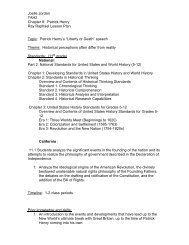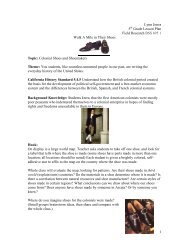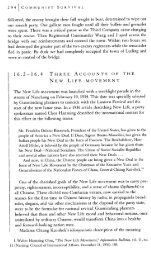Seneca Falls Women's Rights Convention Lesson Plan
Seneca Falls Women's Rights Convention Lesson Plan
Seneca Falls Women's Rights Convention Lesson Plan
You also want an ePaper? Increase the reach of your titles
YUMPU automatically turns print PDFs into web optimized ePapers that Google loves.
<strong>Plan</strong>ning and Preparing for the <strong>Convention</strong>:8. The convention, to take place in five days' time, on July 19 and 20 at the WesleyanMethodist Church in <strong>Seneca</strong> <strong>Falls</strong>, was publicized only by a small, unsigned noticeplaced in the <strong>Seneca</strong> County Courier, a local newspaper. "The convention will not be solarge as it otherwise might be, owing to the busy time with the farmers," Mott toldStanton, "but it will be a beginning."9. To Stanton fell the task of drawing up the Declaration of Sentiments that would definethe meeting. Taking the Declaration of Independence as her guide, Stanton submitted that"all men and women had been created equal" and went on to list eighteen "injuries andusurpations" -the same number of charges leveled against the King of England-"on thepart of man toward woman."10. Stanton also drafted eleven resolutions, making the argument that women had a naturalright to equality in all spheres.11. The ninth and most controversial resolution held forth the radical assertion that it was theduty of women to secure for themselves the right to vote. Elizabeth Cady Stantonafterwards recalled that a shocked Lucretia Mott exclaimed, "Why, Lizzie, thee will makeus ridiculous." Stanton stood firm. "But I persisted, for I saw clearly that the power tomake the laws was the right through which all other rights could be secured."The <strong>Convention</strong> Convenes:12. A crowd of about three hundred people, including forty men, camefrom five miles round. No woman felt capable of presiding; the taskwas undertaken by Lucretia's husband, James Mott.13. All of the resolutions were passed unanimously except for womansuffrage (Stanton’s ninth resolution), a strange idea and scarcely aconcept designed to appeal to the predominantly Quaker audience,whose male contingent commonly declined to vote in local, state orFederal elections.14. The eloquent Frederick Douglass, a former slave and now editor of the Rochester NorthStar, however, swayed the gathering into agreeing to the resolution.15. At the closing session, Lucretia Mott won approval of a final resolve "for theoverthrowing of the monopoly of the pulpit, and for the securing to woman equalparticipation with men in the various trades, professions and commerce." One hundredwomen and men signed the <strong>Seneca</strong> <strong>Falls</strong> Declaration-although subsequent criticismcaused some of them to remove their names.





